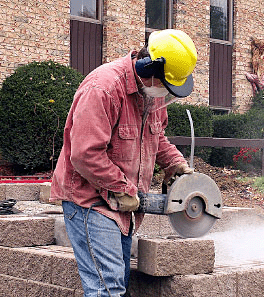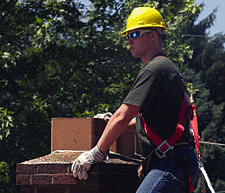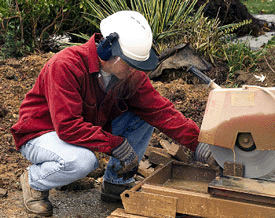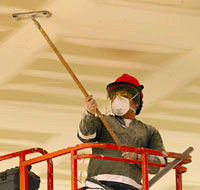Personal Protection on the Job
 The stakes are too high for your personnel, not to mention your company as a whole, to conduct business without preventive safety gear in mind.
The stakes are too high for your personnel, not to mention your company as a whole, to conduct business without preventive safety gear in mind.
There's nothing more beautiful or rewarding than a finished job. Whether you create substantial structures, build walls or pave walkways, looking at that completed design brings a smile to your face, a sense of professional pride to your heart, and maybe a sigh of relief that all the unplanned-for problems were resolved satisfactorily.
But when your building materials consist primarily of brick, block and stone, your long journey from design to completion can be laden with personnel safety hazards. And whether you're the owner of the company or the on-site foreman, personnel safety is an issue you must take care of before the job begins.
Not to be overly dramatic, but in one split second a piece of grit can blind a worker who isn't wearing protective eyewear. The stakes are too high for your personnel, not to mention your company as a whole, to conduct business without preventive safety gear in mind.
Setting the Scene
 From cutting to lifting, the masonry industry offers several scenarios that really bring home the idea of needing to create a safe working environment.
From cutting to lifting, the masonry industry offers several scenarios that really bring home the idea of needing to create a safe working environment.
Unfortunately, the first thing that comes to mind nowadays when you start talking about drilling, cutting or breaking of masonry is the resulting dust that, if inhaled over extended periods of time or in excessive quantities, can cause long-term health problems, such as silicosis, chronic bronchitis, tuberculosis and pneumoconiosis.
Drilling, cutting or breaking of masonry can also project particles at high velocities, with the consequent risk of impact damage and/or injury to exposed body parts, especially the eyes. Without proper protection, these dusty environments can cause eye irritation and short-term vision problems. You also compound your safety problems when a crewmember operating power tools cannot see what they're doing or experiences hindered vision.
Exposure of the skin to aggregates for prolonged periods of time or repeated contact can cause dermatitis. Lifting and manual handling of large rocks, not to mention falling building materials and projectiles, can cause serious injury or even death.
From Head to Toe
 It's not enough to pick and choose to protect some parts of the body, while leaving others uncovered and vulnerable. On average, a complete personal protection system should include respirators, hard hats, eyewear and faceshields, hearing protection, gloves, and protective clothing and footwear. In addition, specialized protection should be included when the need arises, such as personal fall protection when crewmembers are working at heights over six feet or gas detectors if the job site includes possible exposures to toxic or combustible gases or insufficient oxygen.
It's not enough to pick and choose to protect some parts of the body, while leaving others uncovered and vulnerable. On average, a complete personal protection system should include respirators, hard hats, eyewear and faceshields, hearing protection, gloves, and protective clothing and footwear. In addition, specialized protection should be included when the need arises, such as personal fall protection when crewmembers are working at heights over six feet or gas detectors if the job site includes possible exposures to toxic or combustible gases or insufficient oxygen.
Protective industrial helmets, or hard hats, play an important function in protection on the job site, particularly where falling hazards exist. One additional benefit of wearing a hard hat is that other personal protection can easily be attached to protect the face and ears. Safety product manufacturers design faceshield frames so that various types of lightweight plastic and wire-screen faceshields can be quickly snapped into place. Earmuffs can be fastened to the hard hat and raised or lowered when needed. The latest protective helmets have air ventilation slots in the crown and ratchet suspensions for an easy, secure but comfortable fit, and come in all colors and sizes.
Disposable earplugs on cords offer an alternative to helmet-mounted earmuffs because they provide convenience, comfort and low cost as well as high noise-reduction ratings.
Today's protective eyewear comes in stylish colors, with wraparound lenses that resist fogging and protect from the sun's harmful UV rays. Safety glasses are lightweight and have more flexible temples, more comfortable nose bridges and side shields. Lenses can be yellow, blue, green or even reflective mirrored.
Respiratory Protection
 In the masonry industry, hard hats may be the most visible means of personal protection, but it's quite possible that respiratory protection deserves to be tied for first place in importance.
In the masonry industry, hard hats may be the most visible means of personal protection, but it's quite possible that respiratory protection deserves to be tied for first place in importance.
By definition, respirators range from simple disposable particulate facemasks to air-supplied respirators and self-contained breathing apparatus. In most cases, air-purifying respirators with appropriate cartridges and/or filters will serve workers who encounter various hazards on the job. In areas of greater hazards, people working for long hours and/or in higher temperatures may benefit from powered air-purifying respirators.
Because of the great variety of respirators that suit a great variety of exposures, employers must follow the Occupational Safety and Health Administration's (OSHA) requirements for a sound respiratory protection program, starting with a written plan and a complete assessment of respiratory hazards encountered in the workplace. Other key elements include selection, care, and proper fit and use of appropriate respirators, employee training, and medical surveillance of employees.
To keep employees safe and comply with various government standards, starting with OSHA regulations, employers must be knowledgeable about both the range of potential hazards and the types of safety equipment needed. Fortunately, along with continuous technological improvements in materials and design, every year brings new safety products that are lighter, more comfortable, more reliable and even more stylish!
About the Author
James K. Byrnes is the Product Line Manager of Head, Eye, Face and Hearing Protection for MSA Company.


















